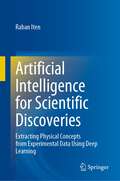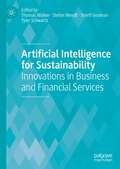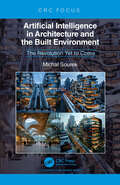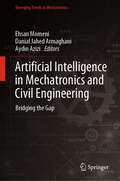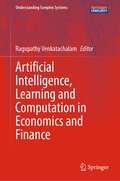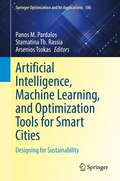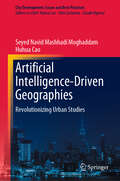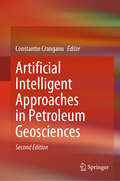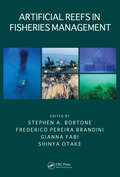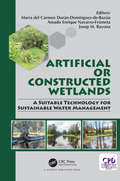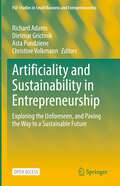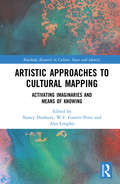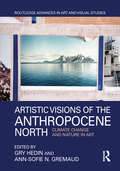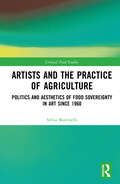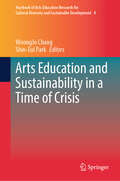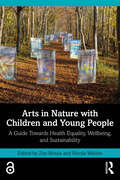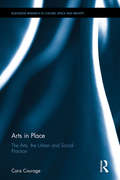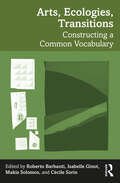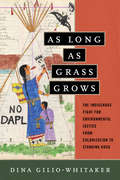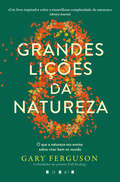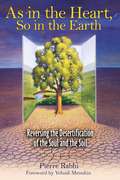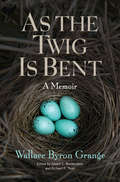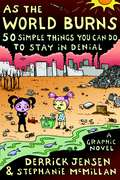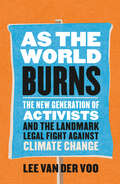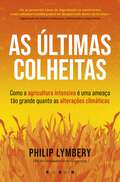- Table View
- List View
Artificial Intelligence for Scientific Discoveries: Extracting Physical Concepts from Experimental Data Using Deep Learning
by Raban ItenWill research soon be done by artificial intelligence, thereby making human researchers superfluous? This book explains modern approaches to discovering physical concepts with machine learning and elucidates their strengths and limitations. The automation of the creation of experimental setups and physical models, as well as model testing are discussed. The focus of the book is the automation of an important step of the model creation, namely finding a minimal number of natural parameters that contain sufficient information to make predictions about the considered system. The basic idea of this approach is to employ a deep learning architecture, SciNet, to model a simplified version of a physicist's reasoning process. SciNet finds the relevant physical parameters, like the mass of a particle, from experimental data and makes predictions based on the parameters found. The author demonstrates how to extract conceptual information from such parameters, e.g., Copernicus' conclusion that the solar system is heliocentric.
Artificial Intelligence for Sustainability: Innovations in Business and Financial Services
by Thomas Walker Sherif Goubran Stefan Wendt Tyler SchwartzIn light of the climate crisis, businesses are expected to embrace sustainability to reduce their negative impacts on the environment and society, while at the same time strengthening their organisations’ positive impacts. Managing this alongside the traditional requirements of business requires careful handling, and it is small wonder that some are heralding the advantages posed by artificial intelligence (AI) as the missing piece of the puzzle. This edited book aims to present a balanced discussion of the benefits and costs of using AI for the natural environment and society, including an analysis of its potential to help meet the UN’s Agenda 2030 and the Sustainable Development Goals. Researchers, practitioners, regulators, and entrepreneurs at the forefront of sustainable AI solutions share insights into the different sustainable applications of AI and highlight how these new developments may affect and contribute to our fight against climate change and address further environmental and social challenges. This volume will be of great interest to scholars and students of digital business and new technologies, sustainability, and strategy.
Artificial Intelligence in Architecture and the Built Environment: The Revolution Yet to Come
by Michal SourekImagine if every architect had an apprentice who could consistently observe and understand their intentions, take over routine tasks and monitor technical, environmental, and economic constraints. This apprentice would continually improve, freeing the architect to concentrate on truly creative work.This book outlines a plan to turn this vision into reality. It evaluates the development of artificial intelligence from its inception to the present, focusing on the last two decades of applying AI in architectural design and planning; the current state of architectural practice is also examined. Integrating architecture, computer science, AI, robotics, economics, law, neurobiology, and philosophy, the vision is built on three key premises: (i) authentic, poetic creativity that transcends parameterization and algorithmizing, (ii) innovative learning strategies and training approaches not yet applied concerning architectural design, and (iii) the convergence of architecture’s inherent spatiality with virtual reality technology and new theories of human thinking and intelligence, poised for implementation in machine learning.
Artificial Intelligence in Mechatronics and Civil Engineering: Bridging the Gap (Emerging Trends in Mechatronics)
by Aydin Azizi Danial Jahed Armaghani Ehsan MomeniRecent studies highlight the application of artificial intelligence, machine learning, and simulation techniques in engineering. This book covers the successful implementation of different intelligent techniques in various areas of engineering focusing on common areas between mechatronics and civil engineering. The power of artificial intelligence and machine learning techniques in solving some examples of real-life problems in engineering is highlighted in this book. The implementation process to design the optimum intelligent models is discussed in this book.
Artificial Intelligence, Learning and Computation in Economics and Finance (Understanding Complex Systems)
by Ragupathy VenkatachalamThis book presents frontier research on the use of computational methods to model complex interactions in economics and finance. Artificial Intelligence, Machine Learning and simulations offer effective means of analyzing and learning from large as well as new types of data. These computational tools have permeated various subfields of economics, finance, and also across different schools of economic thought. Through 16 chapters written by pioneers in economics, finance, computer science, psychology, complexity and statistics/econometrics, the book introduces their original research and presents the findings they have yielded.Theoretical and empirical studies featured in this book draw on a variety of approaches such as agent-based modeling, numerical simulations, computable economics, as well as employing tools from artificial intelligence and machine learning algorithms. The use of computational approaches to perform counterfactual thought experiments are also introduced, which help transcend the limits posed by traditional mathematical and statistical tools.The book also includes discussions on methodology, epistemology, history and issues concerning prediction, validation, and inference, all of which have become pertinent with the increasing use of computational approaches in economic analysis.
Artificial Intelligence, Machine Learning, and Optimization Tools for Smart Cities: Designing for Sustainability (Springer Optimization and Its Applications #186)
by Panos M. Pardalos Stamatina Th. Rassia Arsenios TsokasThis volume offers a wealth of interdisciplinary approaches to artificial intelligence, machine learning and optimization tools, which contribute to the optimization of urban features towards forming smart, sustainable, and livable future cities.Special features include:New research on the design of city elements and smart systems with respect to new technologies and scientific thinkingDiscussions on the theoretical background that lead to smart cities for the futureNew technologies and principles of research that can promote ideas of artificial intelligence and machine learning in optimized urban environmentsThe book engages students and researchers in the subjects of artificial intelligence, machine learning, and optimization tools in smart sustainable cities as eminent international experts contribute their research results and thinking in its chapters. Overall, its audience can benefit from a variety of disciplines including, architecture, engineering, physics, mathematics, computer science, and related fields.
Artificial Intelligence-Driven Geographies: Revolutionizing Urban Studies (City Development: Issues and Best Practices)
by Huhua Cao Seyed Navid MoghaddamThis groundbreaking book delves deep into the history of AI, the major techniques and algorithms of machine learning and deep learning, and the critical role of data sources and processing in these disciplines. It covers a range of AI applications in human geography, including population distribution, land use, environmental risk assessment, and socioeconomic analysis. In urban planning, the book explores AI-driven approaches to smart cities, transportation management, urban growth prediction, and sustainable development, among others. As AI continues to permeate every aspect of human life, it is essential to understand and address the ethical considerations and challenges associated with AI-driven planning. This book tackles crucial issues such as data privacy, algorithmic bias, equitable access to technology, and the future of employment in the fields of geography and urban planning. In addition, it presents inspiring case studies, highlighting successful AI applications in human geography and urban planning, and offers insights into future research directions and challenges. This book is a must-read for students, researchers, and professionals in geography, urban planning, environmental studies, and related fields. It is also an invaluable resource for policymakers and urban planners seeking to leverage the power of AI to create smarter, more sustainable, and equitable cities and communities. This book equips you with the knowledge and tools to harness the potential of AI, leading the way to a better understanding of our world and a brighter future for all.
Artificial Intelligent Approaches in Petroleum Geosciences
by Constantin CranganuThis book presents cutting-edge approaches to solving practical problems faced by professionals in the petroleum industry and geosciences. With various state-of-the-art working examples from experienced academics, the book offers an exposure to the latest developments in intelligent methods for oil and gas research, exploration, and production. This second edition is updated with new chapters on machine learning approaches, data-driven modelling techniques, and neural networks. The book delves into machine learning approaches, including evolutionary algorithms, swarm intelligence, fuzzy logic, deep artificial neural networks, KNN, decision tree, random forest, XGBoost, and LightGBM. it also analyzes the strengths and weaknesses of each method and emphasizes essential parameters like robustness, accuracy, speed of convergence, computer time, overlearning, and normalization. Integration, data handling, risk management, and uncertainty management are all crucial issues in petroleum geosciences. The complexities of these problems require a multidisciplinary approach that fuses petroleum engineering, geology, geophysics, and geochemistry. Essentially, this book presents an approach for integrating various disciplines such as data fusion, risk reduction, and uncertainty management. Whether you are a professional or a student, you can greatly benefit from the latest advancements in intelligent methods applied to oil and gas research. This comprehensive and updated book presents cutting-edge approaches and real-world examples that can help you in solving the intricate challenges of the petroleum industry and geosciences.
Artificial Reefs in Fisheries Management (CRC Marine Biology Series)
by Stephen A. Bortone Shinya Otake Frederico Pereira Brandini Gianna FabiWhile artificial reefs may have much to offer, they remain an anecdote in the greater scheme of fisheries management, primarily due to the lack of data specific to validating their use. Based on papers presented at the 9th Conference on Artificial Reefs and Artificial Habitats (CARAH) and also including original articles written for this reference,
Artificial or Constructed Wetlands: A Suitable Technology for Sustainable Water Management
by María del Durán-Domínguez-de-Bazúa Amado Enrique Navarro-Frómeta Josep M. BayonaArtificial or constructed wetlands are an emerging technology particularly for tropical areas with water scarcity. For big cities, the sustainable management of water resources taking into account proper use is always challenging. The book presents case studies illustrating the above. As plants and microorganisms are a fundamental part of the correct functioning of these systems, their contribution to the degradation of the organic matter and to the removal and transformation of the pollutant compounds present in the wastewaters is also a highlight of this book.
Artificiality and Sustainability in Entrepreneurship: Exploring the Unforeseen, and Paving the Way to a Sustainable Future (FGF Studies in Small Business and Entrepreneurship)
by Richard Adams Dietmar Grichnik Asta Pundziene Christine VolkmannThis open access edited volume explores the past, present, and future of artificiality and sustainability in entrepreneurship – the unforeseen consequences and ways to advance to a sustainable future. In particular, it connects artificiality, sustainability and entrepreneurship, intertwining artificial with the specific phenomenon of those novel digital technologies that provoke continuous and significant change in our lives and business. Unlike digital entrepreneurship research, which focuses on digital technology development and management, this book covers processes and mechanisms of sustainable adaptability of entrepreneurs, the business logic of start-ups, and the collaborative behaviours under the mass digital transformation, including the prevalence of artificial intelligence. Some of the questions that this book answers are as follows: How has entrepreneurship reacted to such challenges previously? What lessons have been learned and need to be carried forward? How can entrepreneurship and the artefacts of entrepreneurship respond to current challenges? What should be the mindset of the entrepreneur to assure sustainable adaptation? How to embrace and embed the new business logic?
Artistic Approaches to Cultural Mapping: Activating Imaginaries and Means of Knowing (Routledge Research in Culture, Space and Identity)
by Nancy Duxbury W.F. Garrett-Petts Alys LongleyMaking space for imagination can shift research and community planning from a reflective stance to a "future forming" orientation and practice. Cultural mapping is an emerging discourse of collaborative, community-based inquiry and advocacy. This book looks at artistic approaches to cultural mapping, focusing on imaginative cartography. It emphasizes the importance of creative process that engages with the "felt sense" of community experiences, an element often missing from conventional mapping practices. International artistic contributions in this book reveal the creative research practices and languages of artists, a prerequisite to understanding the multi-modal interface of cultural mapping. The book examines how contemporary artistic approaches can challenge conventional asset mapping by animating and honouring the local, giving voice and definition to the vernacular, or recognizing the notion of place as inhabited by story and history. It explores the processes of seeing and listening and the importance of the aesthetic as a key component of community self-expression and self-representation. Innovative contributions in this book champion inclusion and experimentation, expose unacknowledged power relations, and catalyze identity formation, through multiple modes of artistic representation and performance. It will be a valuable resource for individuals involved with creative research methods, performance, and cultural mapping as well as social and urban planning.
Artistic Visions of the Anthropocene North: Climate Change and Nature in Art (Routledge Advances in Art and Visual Studies)
by Gry Hedin Ann-Sofie N. GremaudIn the era of the Anthropocene, artists and scientists are facing a new paradigm in their attempts to represent nature. Seven chapters, which focus on art from 1780 to the present that engages with Nordic landscapes, argue that a number of artists in this period work in the intersection between art, science, and media technologies to examine the human impact on these landscapes and question the blurred boundaries between nature and the human. Canadian artists such as Lawren Harris and Geronimo Inutiq are considered alongside artists from Scandinavia and Iceland such as J.C. Dahl, Eija-Liisa Ahtila, Toril Johannessen, and Björk.
Artists and the Practice of Agriculture: Politics and Aesthetics of Food Sovereignty in Art since 1960 (Critical Food Studies)
by Silvia BottinelliArtists and the Practice of Agriculture maps out examples of artistic practices that engage with the aesthetics and politics of gathering food, growing edible and medicinal plants, and interacting with non-human collaborators. In the hands of contemporary artists, farming and foraging become forms of visual and material language that convey personal and political meanings. This book provides a critical analysis of artistic practices that model alternative food systems. It presents rich academic insights as well as 16 conversations with practicing artists. The volume addresses pressing issues, such as the interconnectedness of human and other-than-human beings, the weight of industrial agriculture, the legacy of colonialism, and the promise of place-based and embodied pedagogies. Through participatory projects, the artists discussed here reflect on the links between past histories, present challenges, and future solutions for the food sovereignty of local and networked communities. The book is an easy-to-navigate resource for readers interested in food studies, visual and material cultures, contemporary art, ecocriticism, and the environmental humanities.
Arts Education and Sustainability in a Time of Crisis (Yearbook of Arts Education Research for Cultural Diversity and Sustainable Development #4)
by WoongJo Chang Shin-Eui ParkThis book is a result of the 4th UNESCO-UNITWIN Symposium that took place in Seoul, Korea, on May 25 and 26, 2021. Held online for the first time due to the Covid-19 pandemic, distinguished arts management and cultural education scholars addressed a timely array of issues, including the power of arts participation to transform behavior and perceptions, inclusivity in arts education, the disruptions and opportunities of the lockdown, the power of arts creativity in broader problem solving, the role of local arts educators on the transcultural horizon, and the role of international cooperation in reconstituting vibrant national arts scenes. Encompassing visual, written, and performance arts education from primary through higher education, this book provides a unique window into the power of the arts to meet the harrowing tests we continue to face in the context of the global pandemic. The book offers a unique perspective that is both international in scope and addresses local responses to an unprecedented global pandemic with an emphasis on the Korean and East Asian context.
Arts in Nature with Children and Young People: A Guide Towards Health Equality, Wellbeing, and Sustainability
by Nicola Walshe Zoe MoulaThis novel text brings together research and practice on the intersection between arts and nature and their impact on children and young people’s wellbeing, health equality and sustainability.Existing literature focuses on either the impact of the arts or the impact of being in/with nature on children’s and young people’s wellbeing. However, the intersection between the two – arts and nature – and their combined effect on wellbeing has received limited attention. Through five research-based and seven practice-based chapters, this book draws upon arts-in-nature practices that incorporate visual arts, music, movement, drama and poetry, in a range of natural environments, such as forests, beaches, greenhouses, parks, community areas and school playgrounds.Arts in Nature with Children and Young People will appeal to anyone working with children and young people, including mental health and healthcare professionals, teachers, researchers, artists, and arts therapists. It is also an accessible guide for parents and families looking for inspiration and ideas for creative and outdoor activities.
Arts in Place: The Arts, the Urban and Social Practice (Routledge Research in Culture, Space and Identity)
by Cara CourageThis interdisciplinary book explores the role of art in placemaking in urban environments, analysing how artists and communities use arts to improve their quality of life. It explores the concept of social practice placemaking, where artists and community members are seen as equal experts in the process. Drawing on examples of local level projects from the USA and Europe, the book explores the impact of these projects on the people involved, on their relationship to the place around them, and on city policy and planning practice. Case studies include Art Tunnel Smithfield, Dublin, an outdoor art gallery and community space in an impoverished area of the city; The Drawing Shed, London, a contemporary arts practice operating in housing estates and parks in Walthamstow; and Big Car, Indianapolis, an arts organisation operating across the whole of this Midwest city. This book offers a timely contribution, bridging the gap between cultural studies and placemaking. It will be of interest to scholars, students and practitioners working in geography, urban studies, architecture, planning, sociology, cultural studies and the arts.
Arts, Ecologies, Transitions: Constructing a Common Vocabulary
by Makis Solomos Roberto Barbanti Isabelle Ginot Cécile SorinArts, Ecologies, Transitions provides in-depth insights into how aesthetic relations and current artistic practices are fundamentally ecological and intrinsically connected to the world. As art is created in a given historic temporality, it presents specific modalities of productive and sensory relations to the world. With contributions from 49 researchers, this book tracks evolutions in the arts that demonstrate an awareness of the environmental, economic, social, and political crises. It proposes interdisciplinary approaches to art that clarify the multiple relationships between art and ecology through an exploration of key concepts such as collapsonauts, degrowth, place, recycling, and walking art. All the artistic fields are addressed from the visual arts, theatre, dance, music and sound art, cinema, and photography – including those that are rarely represented in research such as digital creation or graphic design – to showcase the diversity of artistic practices in transition.Through original research this book presents ideas in an accessible format and will be of interest to students and researchers in the fields of environmental studies, ecology, geography, cultural studies, architecture, performance studies, visual arts, cinema, music, and literature studies.
As Long as Grass Grows: The Indigenous Fight for Environmental Justice, from Colonization to Standing Rock
by Dina Gilio-WhitakerThe story of Native peoples' resistance to environmental injustice and land incursions, and a call for environmentalists to learn from the Indigenous community's rich history of activismThrough the unique lens of "Indigenized environmental justice," Indigenous researcher and activist Dina Gilio-Whitaker explores the fraught history of treaty violations, struggles for food and water security, and protection of sacred sites, while highlighting the important leadership of Indigenous women in this centuries-long struggle. As Long As Grass Grows gives readers an accessible history of Indigenous resistance to government and corporate incursions on their lands and offers new approaches to environmental justice activism and policy. Throughout 2016, the Standing Rock protest put a national spotlight on Indigenous activists, but it also underscored how little Americans know about the longtime historical tensions between Native peoples and the mainstream environmental movement. Ultimately, she argues, modern environmentalists must look to the history of Indigenous resistance for wisdom and inspiration in our common fight for a just and sustainable future.
As Oito Grandes Lições da Natureza: O Que a Natureza Nos Ensina Sobre Viver Bem no Mundo
by Gary FergusonO que a natureza nos ensina sobre viver bem no mundo Um manifesto poderoso sobre a interdependência de tudo o que existe na natureza e sobre como poderemos viver uma vida mais gratificantes e nos reconectarmos com o mundo natural. Durante demasiado tempo, vivemos separados da natureza, vendo-nos como superiores, distantes, independentes. Porém, ao fazê-lo, perdemos de vista tudo o que o mundo natural nos pode ensinar. Neste livro, Gary Ferguson revela-nos as surpreendentes complexidades que podemos encontrar na natureza, bem como a sabedoria que advém do mundo natural, da sua diversidade, dos seus mistérios e da sua capacidade de resiliência perante a mudança. Baseando-se em áreas que vão desde a ciência e a psicologia à filosofia e à história, Gary Ferguson desvenda a deslumbrante teia de conexões que temos com a natureza, enfatizando a necessidade de voltarmos a estabelecer uma ligação com o mundo natural para potenciarmos o nosso bem-estar físico, mental e espiritual e redescobrirmos a nossa humanidade. Porque, afinal, nós somos natureza. «Um livro que nos faz refletir e nos ensina a viver em harmonia e equilíbrio com o mundo em nosso redor.» Kirkus Reviews
As in the Heart, So in the Earth: Reversing the Desertification of the Soul and the Soil
by Yehudi Menuhin Pierre RabhiThe world’s leading expert on reversing soil desertification shows how ecology can flourish only when spiritual elements are present• Uses a parable from the African oral tradition to provide a living testimony of what has been lost with the rise of modern technology• Provides a vital account of the strong relationship between soil and soul and how this relationship can be restoredAs in the Heart, So in the Earth is a strong indictment of a civilization that, while seeking domination over the earth, mutilates, tortures, and desacralizes it. For Pierre Rabhi ecology is inseparable from spirituality. He shows how the growing desertification of North Africa is a reflection of the “desert” that is claiming the hearts and souls of the inhabitants of the Western world--how dead soil is mirrored in our deadened souls--and how reconciliation with Mother Earth must be accompanied by relearning our ancestors’ reverence for the soil.Using a traditional African parable grounded in the very wisdom of the earth, Pierre Rabhi seeks to initiate the reader into a time when the people that dwelled on this planet did so harmoniously and could converse easily with the land. Village elder Tyemoro recounts the gradual destruction of his village’s culture and all that has sustained it as the miracles promised by modern technology brought more harm than good. This same drama is recurring throughout the world, where indigenous value systems that have endured for millennia are torn apart by contact with modern civilization. Yet Rahbi offers hope--if those in the modern world will stop to hear the words of their ancestors who worked the land, for our destiny is linked irrevocably to that of the earth.
As the Twig Is Bent: A Memoir
by Wallace Byron GrangeWallace Byron Grange (1905–87) was an influential conservationist who worked alongside Aldo Leopold. Grange’s story vividly describes his mostly idyllic childhood watching bird life in the once grand prairies just west of Chicago. He documents his family’s journey and pioneering struggle to operate a farm on the logged cutover country in northern Wisconsin, a land that provided him with abundant opportunities to study the lives of wild creatures he loved most. Written when Grange was in his sixties, As the Twig Is Bent conveys how a leading conservationist was formed through his early relationship to nature. In beautifully composed vignettes, he details encounters both profound and minute, from the white-footed mice attracted by cookie crumbs in his boyhood clubhouse to the sounds of great horned owls echoing through the wintry woods. As he develops his own understanding of the natural world, he comes to an awareness of the dramatic and devastating role of humankind on ecosystems. Grange’s poignant observations still resonate today amid global conversations about the fate of our natural resources and climate change.
As the World Burns: 50 Simple Things You Can Do to Stay in Denial
by Derrick Jensen Stephanie McmillanTwo of America's most talented activists team up to deliver a bold and hilarious satire of modern environmental policy in this fully illustrated graphic novel. The U.S. government gives robot machines from space permission to eat the earth in exchange for bricks of gold. A one-eyed bunny rescues his friends from a corporate animal-testing laboratory. And two little girls figure out the secret to saving the world from both of its enemies (and it isn't by using energy-efficient light bulbs or biodiesel fuel). As the World Burns will inspire you to do whatever it takes to stop ecocide before it's too late. <P><P> <i>Advisory: Bookshare has learned that this book offers only partial accessibility. We have kept it in the collection because it is useful for some of our members. Benetech is actively working on projects to improve accessibility issues such as these.</i>
As the World Burns: The New Generation of Activists and the Landmark Legal Fight Against Climate Change
by Lee van der Voo&“The story of Juliana v. United States and the committed young people behind it will give you hope in the next generation.&” —Elizabeth Kolbert, author of The Sixth Extinction Do children have a right to inherit a livable planet? Is the government obliged to protect it? That&’s the question posed by Juliana v. United States, one of the most critical lawsuits of our time. Twenty-one young people from across America sued the federal government over climate change, charging that actions promoting a fossil fuel economy violate their constitutional rights to life, liberty, and property. Their trial could be the civil rights trial of the century, but it hasn&’t happened yet. As the World Burns follows the plight of the young plaintiffs, chronicling their legal battle through a year of drought and wildfire, floods and hurricanes, and the most tumultuous political season in modern history. The plaintiffs wrenchingly describe personal experiences with recurring &“thousand-year&” floods, wildfire smoke so thick they can&’t ride a bike to school, drought that threatens family farms, and disappearing coastlines that send waves lapping ominously at their doors. Along the way, journalist Lee van der Voo weaves their experience into a broader narrative of America, where politics and policy threaten the very existence of our youth and our way of life.As the World Burns is climate breakdown like you&’ve never seen it—through the eyes of the young.
As Últimas Colheitas: Como a Agricultura Intensiva É uma Ameaça Tão Grande Quanto as Alterações Climáticas
by Philip LymberyUma visão provocadora do futuro, que nos desafia a pensar melhor acerca do que compramos e comemos, e do impacto das nossas escolhas nas alterações climáticas. Partindo de um alerta perturbador das Nações Unidas de que os solos do mundo se podem esgotar no período de uma vida, Philip Lymbery, uma das pessoas mais influentes na indústria alimentar, percorre os bastidores do grande agronegócio em vários pontos do mundo, revelando como a pressão sobre os solos constitui uma ameaça séria à nossa sobrevivência. Nas suas pesquisas, porém, o autor também encontra esperança nas práticas de pioneiros que estão a repensar os métodos agrícolas, a redescobrir técnicas tradicionais e a desenvolver tecnologias para alimentar uma população global em constante expansão. Influente e persuasivo, este livro alerta para a realidade do sistema alimentar global, demonstrando como podemos regenerar os solos do mundo, acabar com a crueldade animal, salvar a vida selvagem, estabilizar o clima e salvaguardar o planeta para as gerações futuras. Os elogios da crítica: «Philip Lymbery expõe este assunto essencial sob a perspetiva de um ativista experiente — conhecedor o suficiente para ficar chocado, mas suficientemente moderado para nos persuadir a assumir a responsabilidade pelo sistema que nos alimenta.» — The Guardian«Neste livro extremamente bem escrito, cuja leitura aconselho vivamente, Philip Lymbery descreve como a agricultura intensiva prejudica o meio ambiente e inflige sofrimento aos animais sencientes, propondo alternativas sustentáveis para resolver o problema. Há de facto esperança para o nosso planeta, e cada um de nós pode desempenhar um papel.» — Jane Goodall, primatologista fundadora do Instituto Jane Goodall e mensageira da paz das Nações Unidas«Um livro extremamente importante que deve ser lido por todos os que desejam que a humanidade sobreviva para além do período de uma vida. As soluções propostas devem ser implementadas como se o nosso futuro dependesse disso — e de facto depende.» — Andrew Knight, Professor de Ética e Bem-Estar Animal da Universidade de Winchester «Um relato persuasivo e contundente sobre como a agricultura industrial está a impulsionar as emergências climáticas e a pôr em risco a biopersidade, ao mesmo tempo que prejudica a nossa saúde. Este livro é um apelo à ação.» — Isabella Tree, autora e jornalista premiada
